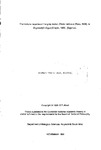The immune response of the grey mullet, Chelon labrosus (Risso, 1826), to Cryptocotyle lingua (Creplin, 1825), (Digenea)
| dc.contributor.author | WOOD, BRADBURY PATRICK | |
| dc.contributor.other | School of Biological and Marine Sciences | en_US |
| dc.date.accessioned | 2013-10-21T09:38:11Z | |
| dc.date.available | 2013-10-21T09:38:11Z | |
| dc.date.issued | 1990 | |
| dc.identifier | NOT AVAILABLE | en_US |
| dc.identifier.uri | http://hdl.handle.net/10026.1/2237 | |
| dc.description.abstract |
The ability of thick-lipped grey mullet to mount both humoral and cellular immune responses to Cryptocotyle lingua has been demonstrated here for the first time. Of the 3 procedures for immunisation investigated, namely exposure to live cercariae, intraperitoneal (ip) injection of whole killed cercariae and ip injection of a cercarial sonicate, the former gave the highest primary antibody titres with a peak response at 4 weeks post infection. Peak titres occurred at 5 and 7 weeks after immunisation by ip injection of sonicated cercariae and whole killed cercariae respectively. An enhanced secondary antibody response was observed following challenge by ip injection of sonicated cercariae. Cercariacidal activity, apparently involving complement, was detected in normal serum and enhanced in immune serum. However, the mechanism for complement activation remains uncertain. Parasite antigens were identified following separation by SOS-PAGE and immunoblotting using mullet and rabbit antisera. Mullet failed to respond to certain parasite proteins recognised by rabbit antiserum and in situ immunogold-silver staining demonstrated that mullet. immunised by exposure to live cercariae, were unable to recognise the metacercarial cyst wall. Migration and polarisation of pronephric leucocytes in vitro was enhanced following immunisation but cellular adherence to encysted and unencysted parasites was not observed. In vitro studies further demonstrated a possible role for fish serum in stimulating metacercarial encystment. The intensity of melanisation of the host capsule in metacercarial infections was increased in fish held in total darkness and with increased temperature. The rate of development of the metacercarial tegument and cyst wall and the associated host response was similarly affected by temperature and initial development was inhibited by prior immunisation via ip injection of sonicated cercariae. There was however, no evidence of protection against cercarial infection following such immunisation. These results are discussed in relation to mechanisms of immunity, metacercarial survival strategies and control of metazoan infections in fish. | en_US |
| dc.language.iso | en | en_US |
| dc.publisher | University of Plymouth | en_US |
| dc.title | The immune response of the grey mullet, Chelon labrosus (Risso, 1826), to Cryptocotyle lingua (Creplin, 1825), (Digenea) | en_US |
| dc.type | Thesis | |
| dc.identifier.doi | http://dx.doi.org/10.24382/3978 | |
| dc.identifier.doi | http://dx.doi.org/10.24382/3978 |
Files in this item
This item appears in the following Collection(s)
-
01 Research Theses Main Collection
Research Theses Main


